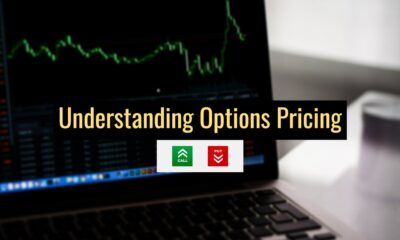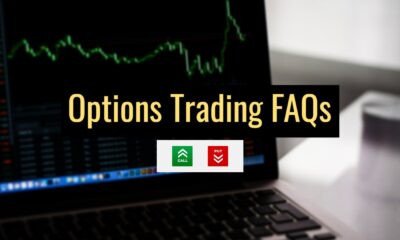Option Trading
Option Trading Basics
Published
2 years agoon
By
Ajit Singh
Options Trading in India accounts for the vast majority of total trade volume at BSE and NSE. The cost of investment in options trading is normally about 3-4% of the investment needed in stock trading. This makes it extremely popular among traders.
OPTIONS OVERVIEW
Options have emerged as a popular investment avenue. In the last few years, we have seen a growing participation from retail investors in the options market. Though options trading is an old phenomenon in the world markets, options trading in India started with the launch of index options on June 4th, 2001. On July 2nd, 2001, stock options were launched. And from there, index and stock options have risen to over Rs 4,45,561 crores in value in 2017-18.
Retail participation in option market
| Year | Index Options | Stock Options | ||
|---|---|---|---|---|
| No. of contracts | Premium Turnover (Rs cr.) | No. of contracts | Premium Turnover (Rs cr.) | |
| 2017-18 | 115,94,95,408 | 3,27,703.55 | 10,02,31,648 | 1,17,858.86 |
| 2016-17 | 106,72,44,916 | 3,50,021.53 | 9,21,06,012 | 95,570.09 |
| 2015-16 | 162,35,28,486 | 3,51,221.01 | 10,02,99,174 | 61,118.39 |
| 2014-15 | 137,86,42,863 | 2,65,315.63 | 9,14,79,209 | 61,732.59 |
| 2013-14 | 92,85,65,175 | 2,44,090.71 | 8,01,74,431 | 46,428.41 |
What is an option?
Options are a form of ‘Derivatives’. Derivatives are financial instruments that derive their value from an ‘underlying’ instrument like stocks of a company, currency, gold, etc.
Curd is a derivative of milk i.e. derived from milk. Similarly, options are derived from an underlying financial instrument say a share of a company or a currency or gold.
Now, we all know, as the price of milk moves up and down, the price of curd also move up and down accordingly. The same way price of options moves up and down with the movement in prices of its underlying instrument.
How options are traded?
In the normal stock market, investors buy and sell shares. The prices of the shares move up/down frequently in the market. If you think a particular share will move up in the next few days/weeks/months, you buy a quantity of the shares by paying the market value at that time. The transaction value (price of shares + brokerage) is deducted from your trading account and the shares are delivered to your account in a couple of days.
When the share’s price reaches your expectation, you sell it and earn a profit. But if the shares prices go below your buying price, you incur losses when you sell it. In both cases, the shares are deducted from your trading account and the transaction value is credited to your account.
Options trading is a little different from shares trading.
In options, instead of buying shares and getting it delivered to your account, you buy the choice to exercise an action at a predetermined price and within a predetermined period. The action is to buy/sell or opt out. The second difference is that there is no delivery of options. All transactions are settled in cash.
An options contract gives you the option or choice to enter into a deal to buy a fixed number of shares at today’s price at a future date. You need to pay an amount (much smaller than the value of the underlying shares) to buy this choice. The amount you pay is called premium. But if the deal doesn’t look favorable to you at that future date then you have the choice to opt out of it. In that case, you lose the premium paid while buying the choice.
Every option contract mentions its strike price, premium, lot size and expiry date.
Strike price: The price at which the buyer and the seller of an option have agreed to enter the option contract is the strike price. Each option on the underlying has multiple strike prices.
- Premium: The payment made by the buyer to the seller to earn his right of an option contract.
- Expiration day: The last day that the option owner can exercise the option.
- Lot Size: The fixed number of units of the underlying instrument form part of a single Options contract. The lot size differs for each stock and is decided by the exchange.
Now let’s look at how this plays out in an illustration:
Let’s say there is an option available on Infosys for the month of August at the strike price of Rs 2000 and a premium of Rs 200 for a lot size of 100 shares of Infosys. This option allows you the right to buy 100 shares of Infosys at Rs 2000 anytime from now until the end of August. To earn this right, you pay a premium of Rs 200 X 100 shares = Rs 20000. Now, if the market price of Infosys at any time during August is higher than Rs 2200, then you may exercise the right and earn profits. But if you see that the price is lower than Rs 2200 and exercising the deal will result in losses, in that case, you can choose to opt out. You will lose the premium amount paid at the time of buying the options.
So an option allows you to buy shares when it is profitable to you and opt out of the deal when you see there’s loss for you.
Types of Options
Options are of two types – Calls and Puts
Calls give you the right, but not the obligation to buy a given quantity of the underlying asset, at a stated price on or before a predetermined future date.
Puts give you the right, but not the obligation to sell a given quantity of the underlying asset, at a stated price on or before a predetermined future date.
Options can be classified as European or American based on the type of exercise. American Options are contracts that can be exercised at any time up to the expiration date while European options can be exercised only on the expiration date. In India, American Options can be exercised on individual securities like Reliance, SBI, etc. and options on indexes like Nifty 50, Nifty bank etc., are European options.
Example of a Call Option
You buy a call option on SBI for August month at the strike price Rs 1000 and a premium of Rs 100 for a lot size of 100 shares. This allows you the right to buy 100 shares of SBI at Rs 1000 anytime from now until the end of August. To earn this right, you pay a premium of Rs 100 X 100 shares = Rs 10000. Now, if the market price of SBI at any time during August is higher than Rs 1100, then you may exercise the right and earn profits. Say the option price is Rs 1150 on expiry. As all the financial derivative contracts are settled in cash, and no delivery of the underlying is made, the contract will be settled by paying you an amount of-
Rs 150 (Strike Price- Market Price) X 100 shares= Rs 15000.
Your profits will be Rs 15000 – Rs 10000 = Rs 5000.
Now, if on the expiry date the stock price falls below Rs 1000, then you have the right not to exercise this option. You would only lose the premium amount of Rs 10,000 paid at the time of calling the option.
Example of a Put Option
You buy a Put option on SBI at the strike price of Rs 1200, at a premium of Rs 50 for a lot size of 100 shares. You pay a premium of Rs 50 X 100 = Rs 5000 while buying the option. If the market price of SBI on the expiry day is less than Rs 1250, then you will earn profits by exercising your right to sell the option. However, if the stock price had increased over Rs 1250 then you could choose not to exercise the option and lose the premium.
Some options related jargons you must know:
- In the money: For a Call option, ‘In the money’ means the underlying instrument price is trading higher than the strike price. For a Put option, ‘In the money’ means the underlying instrument price is trading lower than the strike price.
- Out of the money: For a Call option, ‘Out of the money’ means the underlying instrument price is trading lower than the strike price. For a Put option, ‘In the money’ means the underlying instrument price is trading higher than the strike price.
- At the money: When the underlying price is equal to the strike price.
Best Options Trading Platform Reviews
| Trading Platform Name | Broker | Active Clients | Open Account |
|---|---|---|---|
| Zerodha Pi | Zerodha | 6224309 | Open Account |
| Zerodha Kite | Zerodha | 6224309 | Open Account |
| Ventura Pointer | Ventura | 101814 | |
| Upstox Pro | Upstox | 2115141 | Open Account |
| Tradeplus Infini | Tradeplus | 12906 | Open Account |
| Sharekhan TradeTiger | Sharekhan | 664848 | Open Account |
| Sensibull | |||
| Omnesys NEST | |||
| NSE NOW | |||
| Kotak KEAT Pro X | Kotak Securities | 911880 | Open Account |

Trading in options is a little more complicated than trading in shares. So, then why would investors trade in options? Options trading offers some major benefits that are not available in stocks trading like:
Benefits of Options Trading (Advantages of Options Trading)
Small investment, higher profits
Called leverage in trading parlance, trading in options offers you the opportunity to make higher gains with a small investment. This is because when you buy options, you don’t pay for the value of shares but a premium amount which is much smaller than the value of shares. And the profit you make is the change in the value of the shares.
Let’s understand this with an example:
Options Trading Example 1
Say you purchase a TATA MOTORS Option available at a strike price of Rs 2000 at Rs 200 premium for a lot size of 100 shares. To buy this option, you pay Rs 200 (premium per share) X 100(lot size)= Rs 20,000. If the share value of TATA MOTORS moves up to Rs 2500 within the expiry period, you will earn Rs 500 X 100= Rs 50,000. The net profit after deducting the premium amount paid Rs 20000 will be Rs 30000.
Now if you had traded in shares during the period, you would need to invest Rs 2000 (share price) X 100= Rs 2,00,000 and you would have made a profit of Rs 500 (price movement) X 100 = Rs 50,000.
So, options offer you the opportunity to earn more profit per rupee invested than shares.
Benefit of earning profits in both, rise and fall in the price of the underlying instrument:
At times, as an investor, you’re not sure which way a particular stock or an instrument will move but are sure that some event will definitely cause significant movement in the share price. This happens during the time of the announcement of quarterly results, budget, policy changes, etc. In such times, you can make use of ‘Long Straddle Option Trading Strategy’. The strategy involves buying both, a call and a put option, at the same strike price and expiration. This allows you to make a profit when there is a significant price movement in the share of the company, irrespective of whether it moves up or down.
Let’s understand it with an example:
Options Trading Example 2
Just ahead of its quarterly results, Reliance Options is available for –
Call option at a strike price of Rs 2,000 at a premium of Rs 200 for a lot size of 100 shares.
Put options at a strike price of Rs 2,000 at a premium of Rs 210 for a lot size of 100 shares.
You buy both by paying Rs 20,000 for the call option and Rs 21,000 for the put option.
If the share price of Reliance rises to Rs 2500, you exercise the call option and earn-
Profits = [(current price- strike price)X(lot size)]-(premium paid)]
Profits = [(2,500-2,000)X(100)]-(20,000)] = Rs 30,000
But you would also lose the premium amount of Rs 21,000 paid for the put option and hence your net profit would be Rs 9,000.
If the share price of Reliance falls to Rs 1500, you exercise the buy option and earn-
Profits = [ (Strike price- current price) X (lot size)]- (premium paid) ]
Profits = [ 2,000-1,500) X (100)]- (21,000) = Rs 29,000
Here again, you would also lose the premium amount of Rs 20,000 paid for the call option and hence your net profit would be Rs 9,000.
Acts as an insurance against your current investments:
We buy insurance to protect ourselves against financial losses arising out of an unfortunate event. Options can also be used as insurance to protect your investments. We all know, a put option gives you the right to sell at a set price within a certain period. Buying a put option, when you also own the underlying instruments, is like insuring your investments against a possible decline in its value.
Suppose you own 1000 units of BAJAJ AUTO, currently trading at Rs 5000. The put option for BAJAJ is available at the strike price of Rs 5000 for a premium of Rs 300. You buy the put option by paying a premium amount of Rs 3,00,000. Now even if the share price falls to Rs 3000 in next couple of months, you would be able to exercise the put option and sell at Rs 4700 (strike price- premium) and limit your losses. On the other hand, if the share price moves up to Rs 6000 next month, your insurance won’t have much value but still, you are protected till the expiry date. Also, your investments have gained from the rise in the share price. A put option of Rs 3,00,000 helps you protect an investment of 50,00,000 from downside price movement.
Risks in Options trading (Disadvantages of Options Trading)
One may wonder – when trading in options has so many benefits then why some investors shy away from investing in it? Like every investment, trading in options has its share of risks like:
- Requires good understanding to make profits: Many investors jump into options trading looking at the leverage it offers for higher gains with small investments. But options are a little complicated to understand. So investors need to spend some time understanding options in detail before taking the plunge into options trading.
- Short-term investments: Options are short-term investments that run for a few months. The shorter time gives less time for price recovery. So the chances of losing money are also as high as earning profits out of it.
- Prices may move sharply: Options being a derivative of stocks, indexes etc., a small movement in the underlying stock or index price can cause sharp movement in the options pricing.
A possibility of losing all the capital: In adverse market conditions, you may lose all the capital paid in premiums.
Options are high risk, high reward play. However, if done with proper understanding and strategies, one can minimize risks and profit from trading in options.
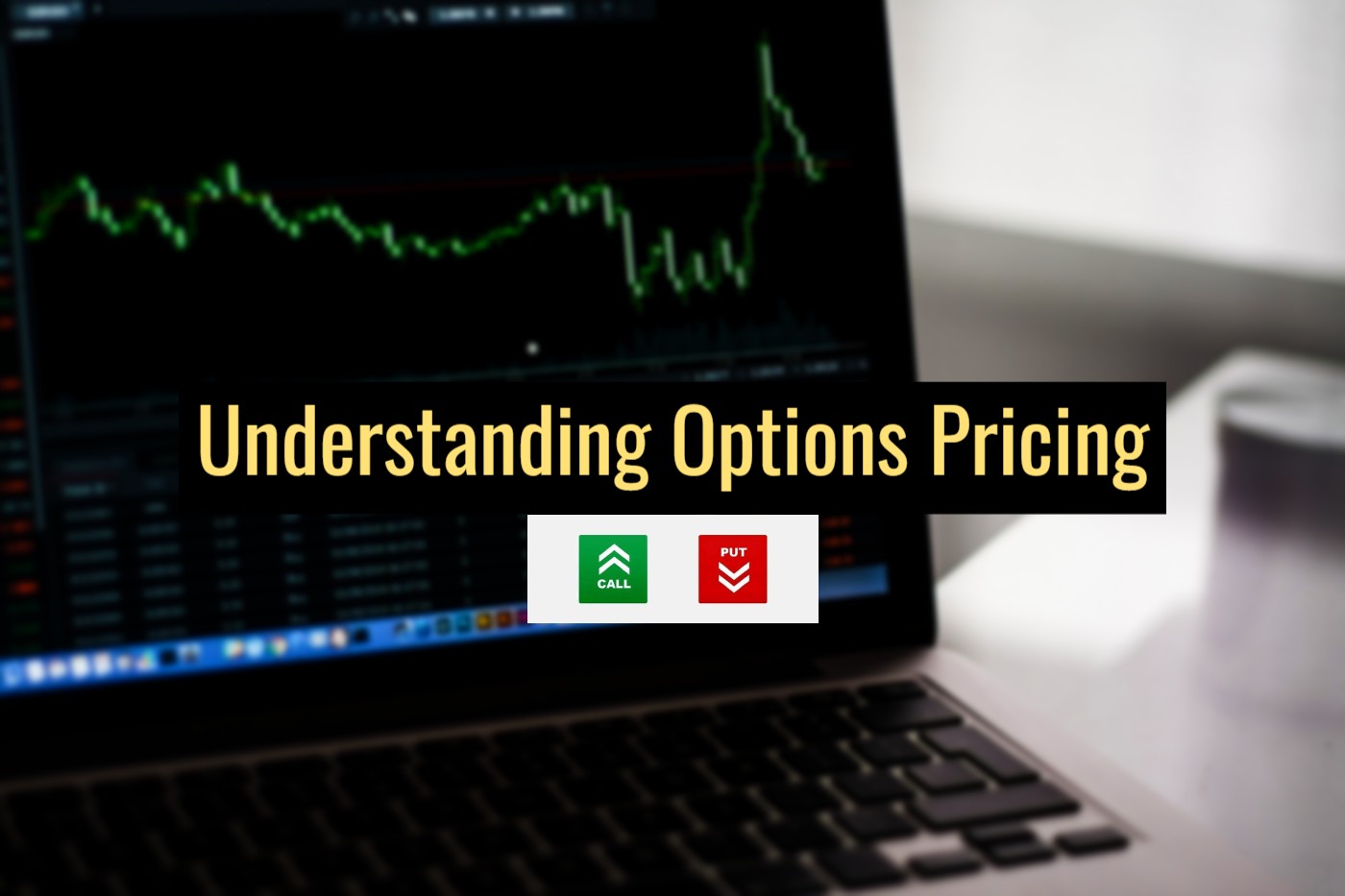
Before getting started with trading options, you should have a good understanding of options pricing and the various factors that play a role in establishing the value of an option. There are also several option pricing models that are used to identify the value of a call or a put option. A solid understanding of options pricing factors and models will help you take advantage of price movements and optimize your earnings from your investments.
Understanding option pricing (Option Premium Explained)
Option pricing is the amount per share you have to pay to trade an option. The price of an option is also known as the premium. The buyer of an option needs to pay the premium amount to the seller to earn the rights granted by the option. Option premiums are priced per share. Since options are available in lots of shares called lot size, you need to pay:
Total Premium Amount= (premium price per share) X (lot size)
For example, say TCS option with a strike price of Rs. 2,500 is available at a premium of Rs. 20 per share for a lot size of 100 shares. To buy the option, you need to pay a premium amount of Rs. 20 X 100 = Rs. 2,000. The premium paid is non-refundable whether you choose to exercise your option or not.
What are the main factors determining an Option’s Price or Premium?
There are many factors that influence the price of an option:
1. Value of the option’s underlying asset
As we know, options are derived from underlying instruments like shares, gold, currency etc. The current value or price of the option’s underlying instrument has a direct effect on the price of the call or put option. If the value of the underlying instrument is on the rise then the call option price will increase and put option price will decrease. If the price of the underlying instrument decreases then call option price will decrease and put option price will increase.
2. Intrinsic Value of an Option
Intrinsic value refers to the value of the option if it were exercised today. It is calculated as a difference between the price of the underlying instrument from which the option is derived and strike price. The strike price is the price at which a buyer and a seller decided to enter the contract.
For call options, intrinsic value is calculated as –
- Intrinsic Value = Spot Price – Strike Price
- For put options, intrinsic value is calculated as-
- Intrinsic Value = Strike Price – Spot Price
The intrinsic value of an instrument can only be positive and zero. It cannot be negative.
The intrinsic value of an option helps you in determining the profit advantage in case you wish to exercise the option immediately. It can be also called as the minimum value of an option.
3. Time Value of an Option
It is calculated as the difference between premium and intrinsic value.
Time Value = Premium-Intrinsic Value
The time value is directly related to how much time an option has until it expires. Generally, the longer the time for an option to expire, the higher is the premium. And it decreases as you come closer to the expiry date of the option.
4. Volatility
Volatility is the probability of the price fluctuation (up or down) of the underlying instrument in the market. The higher the volatility of the underlying instrument, the higher the premium. It is because highly volatile stocks have a higher possibility of bringing profits to investors in a short time.
Volatility is of two types – historical and implied. Historical volatility measures the fluctuations observed in an underlying instrument in the past. Implied volatility predicts the fluctuations in the future.
5. Interest Rates
Normally interest rates have nominal influence on options pricing. But it can be a factor if you are trading in options of large size. There is no direct effect of interest rates on options pricing. Its effect is related to the cost of funds. Let’s assume that to trade in a large options contract, you decide to borrow money from banks or use funds from your savings that are earning some interest rates. Whichever way you go, you are paying interest on the loan or losing interest in case of savings. So the cost of your funds now is invested amount plus the interest on it. If the interest rate is high then the cost of money invested is also high. So when interest rates are high, the premium falls and vice versa.
6. Dividends on underlying stocks
In the event of dividend announcements during the life of an option, the exchanges adjust the option positions. As per regulations by SEBI, if the value of the dividend is more than 10% of the spot price of the option on the date the dividend is announced, then the strike price of the options are reduced by the dividend amount on ex-dividend dates. For dividends announced lower than 10% of the spot price, there is no adjustment by the exchange. Dividend announcement decreases the value of the option as the stock value decreases on the ex-dividend date.
Effect of Market Factors on Call option price and Put option price
| Factors Affecting Option Premium | Effect on Call Option Price/Premium | Effect on Put Option Price/Premium |
| Increase in the value of the underlying instrument | Increase | Decrease |
| Increase in Intrinsic Value | Decrease | Increase |
| Increase in Time Value | Increase | Increase |
| Increase in Volatility | Increase | Increase |
| Increase in Interest rates | Increase | Decrease |
| Increase in Dividends | Decrease | Increase |
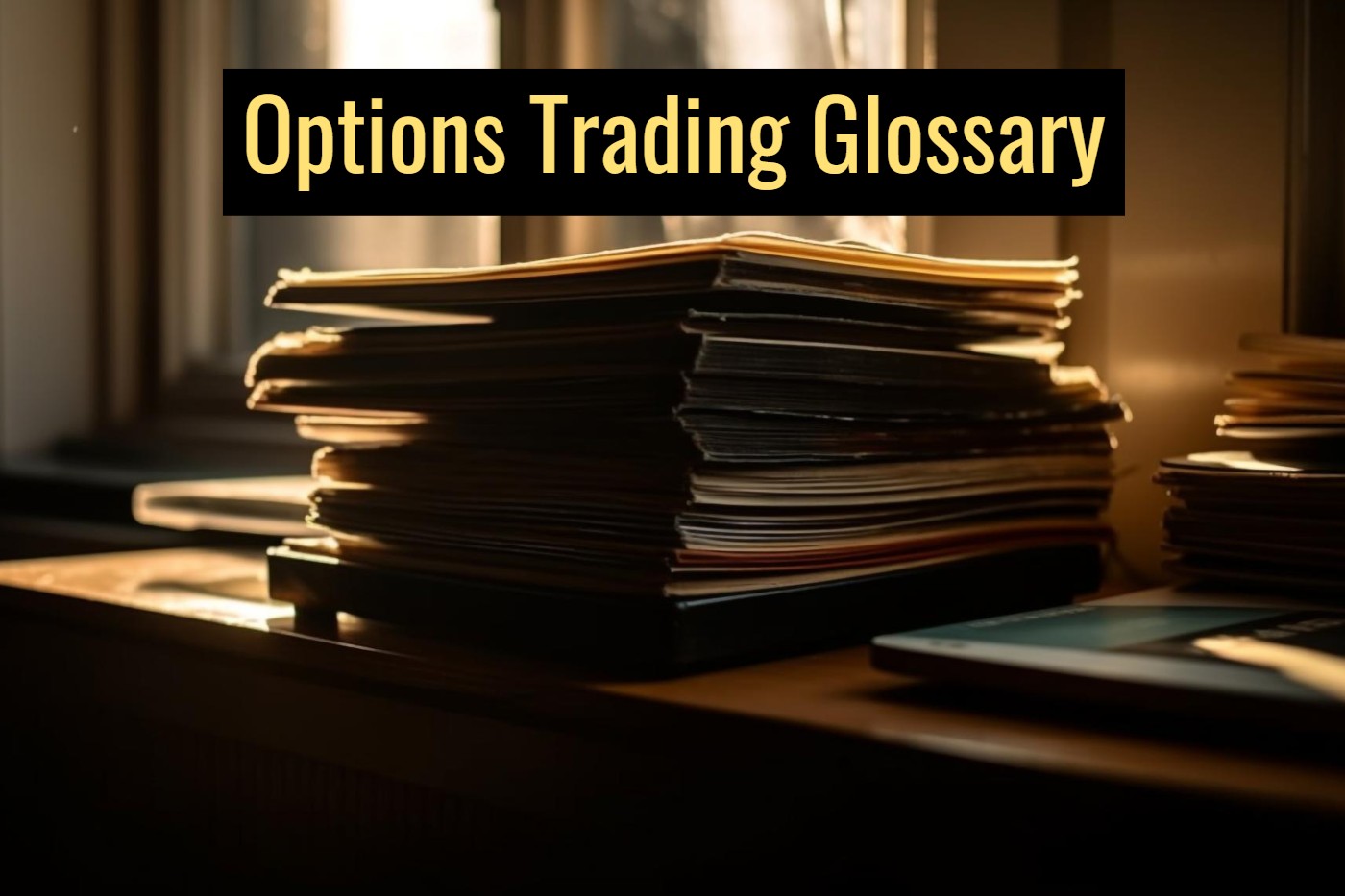
- Algo Trading: Algo trading refers to the utilization of software programs to engage in automated trading.
- American Option: American Options allow for the exercise of the option on any day within the expiration date.
- Assignment in Options: Assignment in Options refers to the ability to exercise an American Option on any day within the expiration date.
- At-the-money (ATM): When the price of an Option is equal to its strike price, it is considered to be at-the-money.
- Bear Call Spread: Bear Call Spread is a trading strategy involving the simultaneous buying and selling of Options with the same underlying asset and expiration date but different strike prices.
- Box Spread: Box Spread is an arbitrage strategy that utilizes Call and Put Options to achieve a riskless profit.
- Box Spread Strategy: Box Spread Strategy is an Option arbitrage strategy employed when the underlying asset is undervalued.
- Break-Even Point (BEP): Break-Even Point (BEP) is the price at which an Option contract neither yields a profit nor incurs a loss.
- Bull Call Spread: Bull Call Spread is a trading position that involves buying and selling Options with the same underlying asset and expiration date but different strike prices.
- Call Option: A Call Option is an Option contract that grants the buyer the right, but not the obligation, to purchase an underlying asset at a specified price within a specified period.
- Cloud Order: Cloud Order is a special feature offered by ICICI securities, enabling traders to create and save orders at any time for execution during market hours.
- Delta Option Greek: Delta measures the extent to which the price of an Option changes in relation to changes in the price of its underlying asset.
- European Option: European Options can only be exercised on the expiration date.
- Exercising Options: Exercising an Option refers to the act of a trader deciding to utilize the rights granted by an Option contract.
- Expiry: Expiry is the final date, typically the last Thursday of the month, on which an Option contract expires.
- Gamma Option Greek: Gamma measures the change in an Option’s Delta in response to changes in its underlying asset.
- In-the-money (ITM): When the price of an Option exceeds its strike price, it is considered to be in-the-money.
- Index Options: Index Options are Option contracts where the underlying asset is an index, such as Nifty 50 or Bank Nifty.
- Long Option: A Long option is a position in which a trader buys an Option.
- Long position: A Long position refers to the act of buying an Option.
- Lot Size: Lot size refers to the number of shares of the underlying asset in an Option contract.
- Mark-to-Market Settlement (MTM): Mark-to-Market Settlement, also known as MTM settlement, is the process of adjusting the profit or loss made on an open position of a derivatives contract on the same day.
- Moving averages: Moving averages are utilized to forecast the direction of a specific Option trend.
- Open Interest (OI): Open interest (OI) is a derivative indicator that represents the total number of unsettled derivative contracts, such as options or futures, at a given point in the market.
- Option Greeks: Option Greeks assist traders in determining the price change of an Option due to various factors.
- Option Market Participants: Participants in the Options market can be categorized into Hedgers, Speculators, and Arbitrageurs based on their risk appetite and trading approach.
- Option Tick Size: Option Tick Size is the minimum increment by which the price of an Option contract can change.
- Option Writer or Option writing: An Option Writer is an individual who sells or shorts an Option without holding the underlying asset of the Option.
- Options Arbitrage: Options Arbitrage is a strategy where a trader takes multiple positions to minimize the risk of their trade.
- Options Chart: Option chains, also known as Options Charts, are used by traders to perform technical analysis on the underlying stock of an Option.
- Options Contract: An Options Contract grants the buyer the right, but not the obligation, to sell an underlying asset at a specified price and on a specific date.
- Options Fair Market Value: Options Fair Market Value is the theoretical price of an Option calculated using Options pricing models.
- Options Hedging: Option contracts serve as useful tools for hedging.
- Options Market: An Options Market is a marketplace where traders buy and sell Options.
- Options Premium: The price paid by an Option buyer or received by an Option seller is referred to as the premium of an Option.
- Options Secondary Market: The Options Secondary Market is a market where previously issued Options on the NSE and BSE are traded.
- Options Spread: An Options Spread is created by taking two positions, buying and selling Options with the same underlying asset and expiration date.
- Options Trading App: An Options Trading App is a mobile application that enables traders to engage in Options trades from anywhere and at any time.
- Options Writer: An Options Writer is an individual who sells an Option, also known as the seller of the Option.
- Out-of-the-money (OTM): When the price of an Option has not reached its strike price, it is considered to be out-of-the-money.
- Over The Counter (OTC) Options: Options that are traded away from exchanges like NSE and BSE are referred to as Over The Counter (OTC) Options.
- Paired Option Contracts: Paired Option Contracts allow traders to take two different positions on the same Option in a single order.
- Post-market Trading Hours (Post Close Trading Session): The Post-market Trading Hours, also known as the Post Close Trading Session, is a session conducted between 3:40 PM and 4:00 PM for trading shares at a fixed predetermined price.
- Pre-Market Trading hours: The Pre-Market Trading Hours consist of two sessions, Order Entry and Order Matching, conducted between 9:00 AM and 9:15 AM.
- Put Option: A Put Option is an Option contract that grants the buyer the right, but not the obligation, to sell an underlying asset at a specified price within a specified period.
- Rho Option Greek: Rho measures the change in the price of an Option with every percentage change in interest rates.
- Short Option: A Short Option is a position in which a trader sells an Option.
- Spot Price: The current market price of the underlying asset of an Option is referred to as the Spot Price.
- Squaring Off an Option: Squaring Off an Option involves selling an Option of the same underlying asset, expiration date, and strike price that was previously bought.
- Strike price or exercise price: The Strike price, also known as the exercise price, is the specific price at which an Option is purchased, granting the buyer the right to exercise the Option.
- Synthetic position: A Synthetic position is created by combining different types of Options to create a single Option.
- Theta Option Greek: Theta measures the change in the price of an Option with each passing day towards its expiration.
- Time decay or erosion: Time decay, also known as erosion, refers to the decrease in the value of an Option as time passes.
- Uncovered call writing: Uncovered call writing refers to the act of selling a Call Option without holding the underlying asset.
- Vega Option Greek: Vega measures the impact of changes in the volatility of the underlying asset on the price of its Option.
- Vertical spread option strategy: A vertical spread option strategy is a two-legged strategy involving the buying and selling of Call and Put Options.
- Volatility: Volatility is the rate of change in the price of the underlying asset of an Option.
- Volume in Options: Volume in Options is an indicator of the level of trader interest in a particular Option.
Trending
-
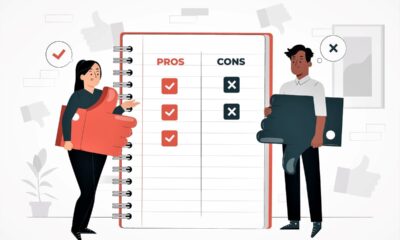
 Broker Reviews2 years ago
Broker Reviews2 years agoCompare Brokers
-

 Broker Reviews2 years ago
Broker Reviews2 years agoBest of Stock Brokers in India
-

 Vastu Shastra9 months ago
Vastu Shastra9 months agoVastu Tips to Enhance the Success Ratio in Broking & Wealth Business
-

 Authorised Person2 years ago
Authorised Person2 years agoAuthorised Person Registration
-

 Franchise2 years ago
Franchise2 years agoFranchise Offers
-

 Demat2 years ago
Demat2 years agoZerodha Demat Account
-
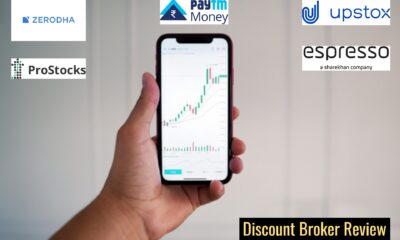
 Broker Reviews2 years ago
Broker Reviews2 years agoDiscount Broker Review
-

 Demat2 years ago
Demat2 years agoDemat




